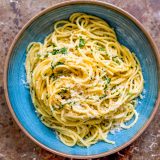Along Italy’s mountainous Amalfi Coast, ring-shaped calamarata pasta is paired with clams, parsley, garlic and fried strips of a sweet local lemon grown on the terraced hillsides. In Sicily, broken pasta comes studded with toasted pistachios, Parmesan and a lemon’s juice and zest. And in Rome, the same citrus juice is simply whisked with olive oil, cream and Parmesan before being tossed with al dente tagliatelle.
In each case—and in countless other Italian pastas—lemon plays a crucial role. The sour, subtly sweet citrus fruit brightens the dish, but it also balances the pasta’s starch and the sauce’s creamy heft.
Lemon functions like the generous dose of freshly ground black pepper that offsets pecorino Romano in cacio e pepe. And it serves much the same role as tomato often does, providing gentle, fruity acidity.
In fact, the pairing of lemons and pasta is arguably more traditional than red sauce itself, as the citrus fruit arrived in Italy at least 1,500 years before tomatoes. It made its way to Italy the same way noodles did: via trade routes from the Middle East and Asia.
At Milk Street, we loved the vibrant simplicity and lightness of Italy’s creamy lemon pastas, but we quickly realized many traditional versions of spaghetti al limone include cream, we found the dairy too easily overpowered the citrus. tent of proteins called caseins, which absorb the aromatic molecules in the fat-soluble oils of the lemon.
Butter, on the other hand, has fewer casein proteins than cream, so it better preserves the lemon’s aroma when emulsified with the lemon oil.
With that in mind, we briefly sautéed minced garlic and red pepper flakes in 3 tablespoons of melted butter. We then added white wine—for another layer of acidity and complexity—to the skillet and reduced the mixture by nearly half.
Meanwhile, we laid the foundation for a light, summery sauce. The key was the pasta cooking liquid: We boiled spaghetti in only 2 quarts of water, half of what we normally use. That created extra-starchy liquid that we could use to add body—but no heft or competing flavor—to our simple lemon-butter sauce.
Once the pasta was nearly al dente, we drained it and transferred it to the skillet, where we added the garlic mixture over medium-high. The pasta and flavorings simmered on the stove with 1 1/2 cups of the cooking water. As the pasta finished cooking, it absorbed much of the flavorful liquid.
Off heat, we stirred in lemon juice and zest along with a heaping handful of parsley (basil also works beautifully), black pepper and 2 more tablespoons of butter. A final sprinkle of nutty Parmesan cheese—just enough to accent, but not overshadow, our sauce—completed the dish.
The recipe required only 10 ingredients, all of which we already had in our pantry, and the result was lighter and livelier than any cream or tomato sauce. But most importantly, flavor perfect for summer.




